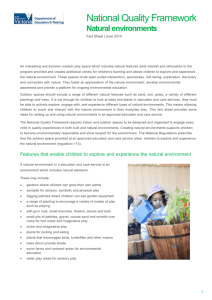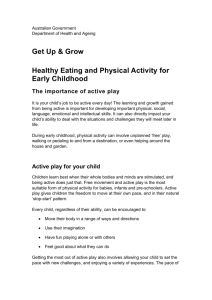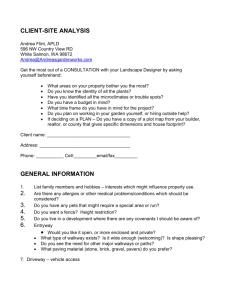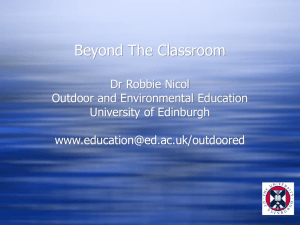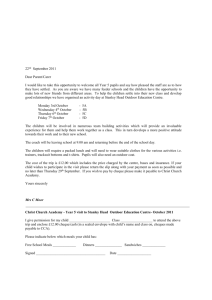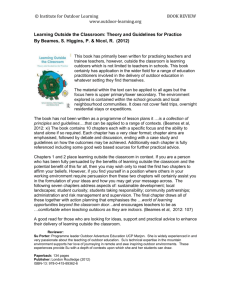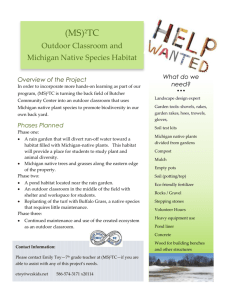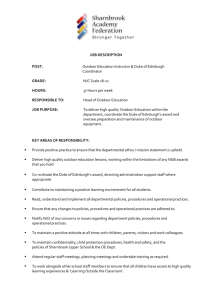Natural Environments - Department of Education and Early
advertisement
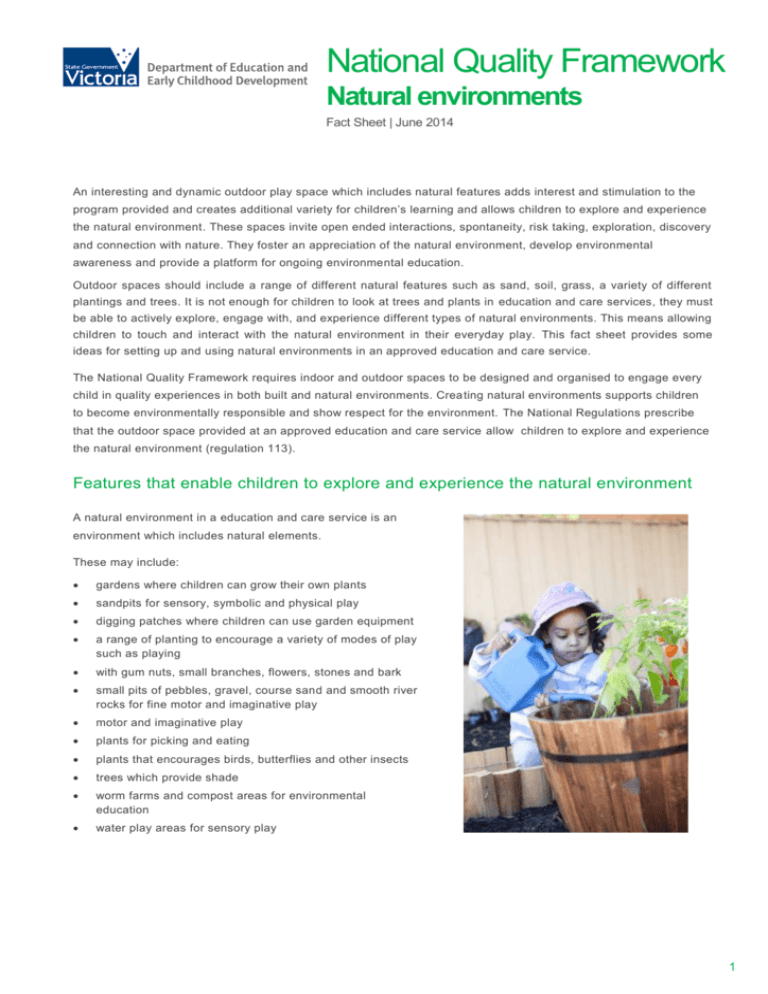
National Quality Framework Natural environments Fact Sheet | June 2014 An interesting and dynamic outdoor play space which includes natural features adds interest and stimulation to the program provided and creates additional variety for children’s learning and allows children to explore and experience the natural environment. These spaces invite open ended interactions, spontaneity, risk taking, exploration, discovery and connection with nature. They foster an appreciation of the natural environment, develop environmental awareness and provide a platform for ongoing environmental education. Outdoor spaces should include a range of different natural features such as sand, soil, grass, a variety of different plantings and trees. It is not enough for children to look at trees and plants in education and care services, they must be able to actively explore, engage with, and experience different types of natural environments. This means allowing children to touch and interact with the natural environment in their everyday play. This fact sheet provides some ideas for setting up and using natural environments in an approved education and care service. The National Quality Framework requires indoor and outdoor spaces to be designed and organised to engage every child in quality experiences in both built and natural environments. Crea ting natural environments supports children to become environmentally responsible and show respect for the environment. The National Regulations prescribe that the outdoor space provided at an approved education and care service allow children to explore and experience the natural environment (regulation 113). Features that enable children to explore and experience the natural environment A natural environment in a education and care service is an environment which includes natural elements. These may include: gardens where children can grow their own plants sandpits for sensory, symbolic and physical play digging patches where children can use garden equipment a range of planting to encourage a variety of modes of play such as playing with gum nuts, small branches, flowers, stones and bark small pits of pebbles, gravel, course sand and smooth river rocks for fine motor and imaginative play motor and imaginative play plants for picking and eating plants that encourages birds, butterflies and other insects trees which provide shade worm farms and compost areas for environmental education water play areas for sensory play 1 The role of educators It is important to think about how the environment is used in early childhood services and the interactions between children, staff members and carers. All educators play an important role in teaching and guiding the children within natural environments. Educators do this by: providing access to a range of natural materials finding ways that children can care for and learn from the land modelling respect, care and appreciation for the natural environment sharing information and providing access to resources about the environment and the impact of human activities on environments embedding sustainability in daily routines and practices looking for examples of interdependence in the environment and discussing the ways the life and health of living things are interconnected. Children’s learning and development in natural environments When children are using the natural environment to develop knowledge in this area this is evidenced by children: showing a growing concern and appreciation for natural environments exploring relationships with other living and non-living things observing, noticing and responding to changes in the environment developing an awareness of the impact of human activity on environments and the interdependence of living things. Why include natural environments in outdoor spaces Current research clearly shows that natural environments and outdoor play are beneficial to children in many ways. Playing outdoors is important for developing capacities for creativity, symbolic play, problem solving and intellectual development. Outdoor play has clear physical benefits for developing children including helping children to acquire gross motor skills, eye-hand coordination and helping to prevent obesity. Sensory stimulation derived from interacting with natural environments allows children to learn with all of their senses. These senses include seeing, hearing, touching and smelling. It is well known that physical activity is beneficial for children in many ways. In a recent review of literature concerning children outdoors, Munoz 1 examines research linking time spent outdoors to increased physical activity, healthy development and overall wellbeing. Research also shows that children who have trouble concentrating benefit from playing outdoors, as after playing outdoors these children are better able to concentrate on tasks. Natural environments give educators in education and care services opportunities to teach children about caring for the world in which we live. Seeing plants grow and change throughout the year helps children to understand and learn more about nature. 1 Munoz, S.A 2009 Children in the outdoors. Sustainable Development Research Centre. Horizon Scotland 2 Including natural environments in outdoor play spaces Including natural elements into an outdoor play space does not have to look a particular way, there is no formula that has to be followed. The design will take into account the size and configuration of the space, the way in which the space is used at the children’s service and the ages of the children who play in the space. An outdoor play space with natural features designed for toddlers in long day care will look very different from an outdoor space with natural features designed for an outside school hours care or family day care service. Considerations when designing or modifying outdoor play spaces with natural environments Natural play spaces can provide rich opportunities for children to explore new ideas and to develop their interests and understanding. When thinking about the design of an outdoor space for children the following opportun ities for children should be provided: to explore and develop a relationship with the natural environment; to gain a sense of freedom; and to explore and to learn the skills required to manage self-risk. It is not necessary to redesign the whole outdoor space in order to include natural features. In addition to trees and other smaller plants and shrubs, pots, tyres and tubs may be used to contain natural materials for play such as stones, sand, soil etc. Flowers can be grown in small tubs and gardens for the children to grow their own plants can be created in raised beds which can be constructed or bought commercially. There are many books on designing outdoor play spaces for children, these will be of help in sourcing ideas. Local expert consultants may be contacted for help with designs for outdoor play spaces and advice about child friendly and hardy plants. Natural environments indoors Natural environments do not have to be limited to outdoors. There are many ways in which the natural environment can enhance the children’s indoor program. Pot plants and small tubs in which to grow plants are visually appealing in children’s rooms. Parts of branches and small logs with the bark attached can be used in imaginative play in conjunction with other materials. Pine cones, seed pods, leaves, gumnuts and small stones can be used in different ways including opportunities for children to explore simple science and maths concepts such as classifying, counting and weighing. Sand and water trays inside also provide additional interesting experiences for children’s play. Approved learning frameworks Learning outcome two in the Victorian Early Years Learning and Development Framework states that ‘Children are connected to and contribute to their world’. This outcome requires educators to help children to develop an awareness of the impact of human activity on the environment and the interdependence of living things. Natural environments within children’s services are the arena in which children learn these things. Belonging, Being and Becoming, the Early Years Learning Framework for Australia examines the practice of early childhood pedagogy and the role that good learning environments play in teaching. ‘Play spaces in natural environments include plants, trees edible gardens, sand, rocks, mud, water and other elements from nature. These spaces invite open ended interactions, spontaneity, risk taking, exploration, discovery and connection with nature. They foster an appreciation of the natural environment, develop environmental awareness and provide a platform for ongoing environmental education’. 3 My Time, Our Place Framework for School Age Care in Australia confirms environments that support wellbeing and development are vibrant and flexible spaces that are responsive to the welfare and abilities of each child . These environments cater for different needs and interests and invite children and fam ilies to contribute ideas and questions. Educators can support engagement by allowing time for meaningful interactions, by providing a range of opportunities for individual and shared experiences, and by finding opportunities for children to go into and co ntribute to their local community. References Belonging Being and Becoming, the Early Years Learning Framework for Australia - Available in the ACECQA Educator and Providers Library on the ACECQA website: www.acecqa.gov.au Written resources Elliot, S (editor). 2008. The outdoor playspace naturally: For children birth to five years. Pademelon Press. Melbourne. Organisations Environmental Education in Early Childhood (Vic) Inc (EEEC) www.eeec.org.au EEEC aims to promote a holistic approach to environmental education and sustainable practices in early childhood and the early years of primary school. The approach involves policy development, house keeping practices, play and learning experiences and strategies for working with children, staff and parents. Australian Association for Environmental Education (AAEE) http://www.aaee.org.au/members/special-interest-group-1/ AAEE is Australia’s peak professional body for Environmental educators. It promotes best practice in and contributes to skills development among educators across the country. The Early Childhood SIG group coordinates, advocates and resources early childhood education for sustainability. Play Australia (formerly Playground and Recreational Association of Victoria) http://www.playaustralia.org.au/ Play Australia supports and work with many different people and agencies in the community, including local government, schools, early childhood centres, playground designers and landscapers and playground manufacturers who have an interest in children and outdoor play experiences. Further information The Department of Education and Early Childhood Development is the Regulatory Authority in Victoria. Phone: 1300 307 415 Email: licensed.childrens.services@edumail.vic.gov.au Web: www.education.vic.gov.au/childhood/providers/regulation 4 The factsheet includes two pages of images which include examples of natural environments at education and care services: Image of outdoor area with a basket and colourful musical instruments sitting on a rug Outside play area with raised wooden walkway and sandy play areas on both sides Image of plastic toy dinosaurs and rocks sitting in a sand pit Image of a sandpit with two flowerpots shaded by a piece of material. There is a water tank and gardens behind it. Image of verandah decking area with a simple mattress and books Image of a cluster of plant pots and a tyre, planted with seedlings and toy plastic dinosaurs Image of sandpit with a natural timber cubby house in the background. The sandpit is covered by a simple patio roof creating shade for children, and has a number of sticks and small tree branches planted by children after their play. Image of a number of tree stumps and plants placed together Image of a sandpit with five brightly coloured plastic spades standing upright in it. The sandpit is surrounded by small stones and rocks.. Image of a play area with chickens walking in it. Behind the playspace is a fenced garden. Image of a chicken walking through a garden area. Image of a play space with swing and climbing frame surrounded by trees and garden, under a shade sail, with coloured plastic ‘rocks’. Image of a number of tree stumps arranged in a circle inside a room. Image of garden play area with trees planted and fabric shading part of the area. Image of area set up for bark painting area with yellow, black and brown paint. There are also examples of indigenous artwork. Image of deck area with tricycle and cushions on it. The lawn area adjacent is surrounded by garden, and has a rug with balls and other play equipment on it surrounded. Image of a garden with raised beds growing vegetables. Image of chicken coop placed in a garden with used car tyres placed in front of it to mark the edge of the path. Close up of a strawberry plant. 5
